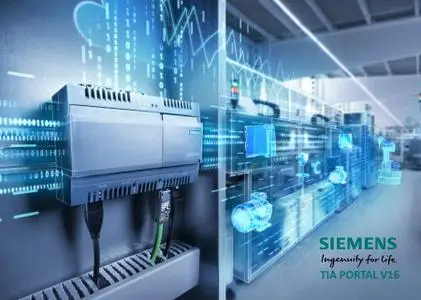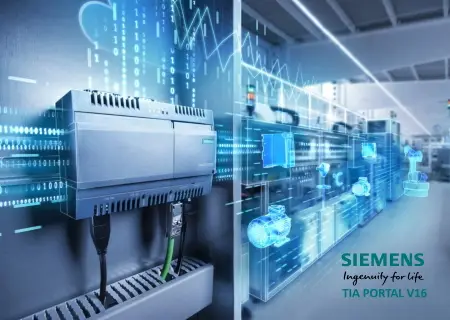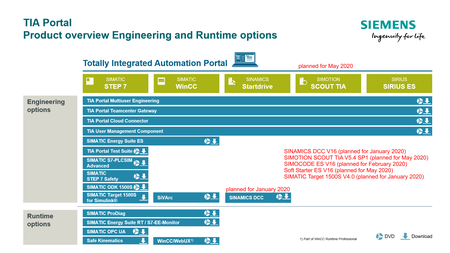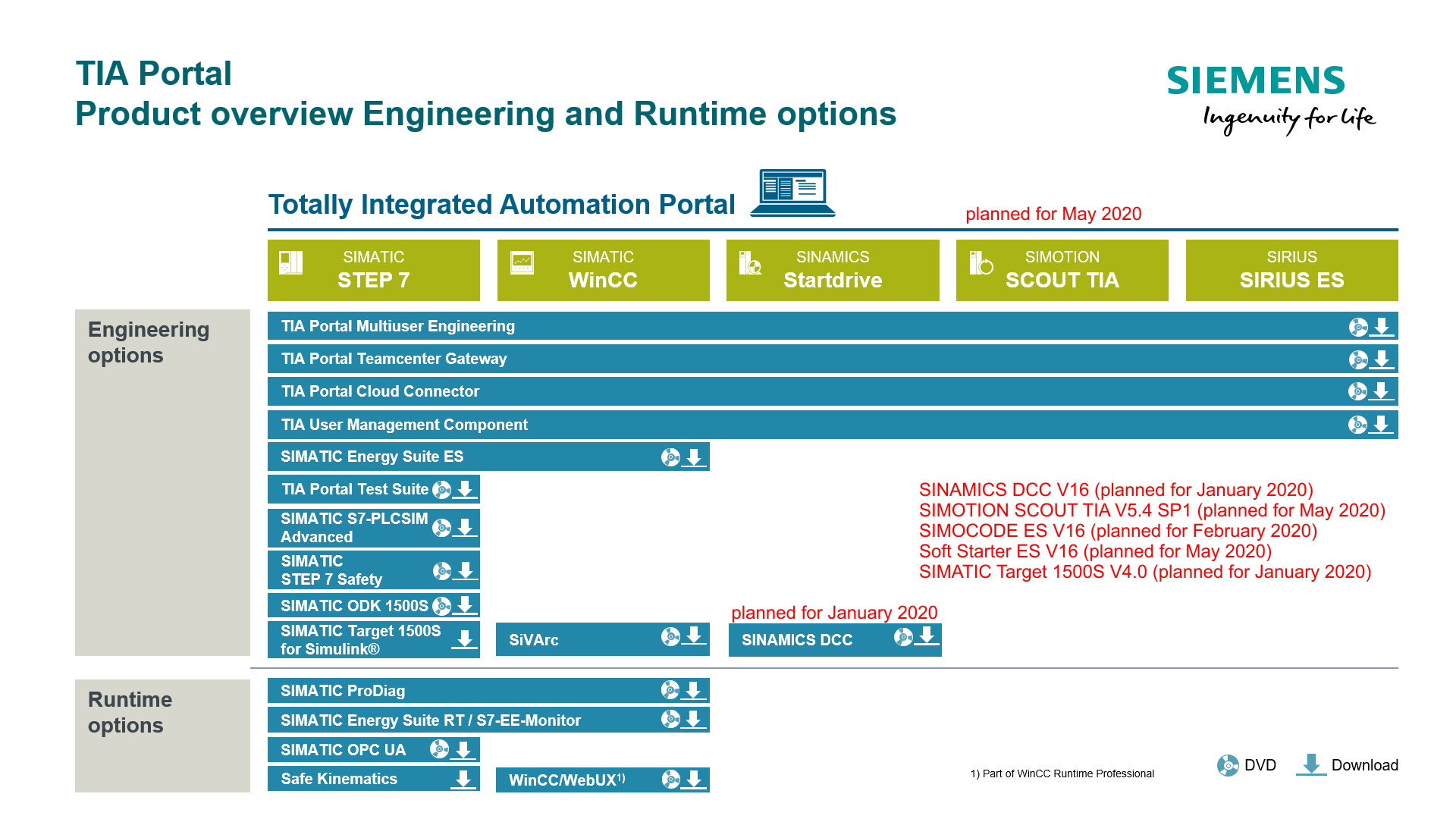Siemens Simatic TIA Portal V16 | 46.2 Gb
Languages: German, English, Italian, French, Spanish, Chinese.
Updated: Fixed due to the lack of 2 parts of archives.
Languages: German, English, Italian, French, Spanish, Chinese.
Updated: Fixed due to the lack of 2 parts of archives.
Siemens, a leading automation company, has enhanced its engineering framework with the introduction of the TIA Portal V16. The new version shortens your time to market, for example by means of simulation tools, increases the productivity of your plant through additional diagnostics and energy management functions, and offers you broader flexibility by connecting to the management level.
Siemens Simatic TIA Portal V16 release notes - 26 November 2019
With the new TIA Portal V16 (Totally Integrated Automation Portal), Siemens has expanded its engineering framework with practical new functions for various phases from planning, to engineering, to commissioning. The innovations concentrate on the continuous integration of the development process. These include standardization, integrated engineering spread across teams and an integrated function test. This enables users to increase the quality of their software, shorten commissioning times and reduce engineering costs.
During the development process, the focus is on distributed working concepts and teamwork. On the TIA Portal project server, the user can now exclusively access server projects via the new Exclusive Engineering function – with features such as project revision and change protocol, as well as automated reporting and archiving. This means there are no functional restrictions when organizing automation tasks on a device, object or function-oriented basis. No special license is required for using Exclusive Engineering. To enable projects to be commissioned by teams, TIA Portal V16 has been expanded with an “asynchronous commissioning” mode, whereby loading to the Simatic S7-1500 controller is carried out by a second TIA Portal instance running in the background. The TIA Portal instance running in the foreground can be operated again immediately, enabling load times to be considerably shortened. TIA Portal V16 includes the new Version Control Interface (VCI) to external versioning systems such as GIT, SVN and TFS. The import and export of software objects via the TIA Portal interface allows versioning to be seamlessly integrated into the development process. This enables object-granular, completely transparent versioning of all software objects outside the TIA Portal. Another innovation is the TIA Portal Test Suite. In addition to allowing automated creation and checking of adherence to programming guidelines, the so-called Styleguide Check, it is also possible to generate and carry out application tests with the virtual S7-PLCSIM Advanced controller. This support reduces engineering and commissioning times and enhances the quality of the software.
With TIA Portal V16, all Simatic S7-1200 controllers are now equipped with OPC UA server functionality. Connection to higher-level systems, such as manufacturing execution systems, can be implemented for vertical data integration. Controller-controller communication throughout all Simatic controllers is also now possible using OPC UA. Standardized interfaces, known as companion specifications, are simple to import with the TIA Portal, making it easy to integrate machines in production lines or plants. The SiOME Siemens OPC UA Modelling Editor helps the automation engineer with the interconnection of tags and simplifies their import into the Simatic machine control. The SiOME also has some new functions such as the creation of data blocks based on OPC UA information models, or the option of checking OPC-UA information models and companion specifications for conformity. Users can now model server interfaces or companion specifications in the TIA Portal V16. In simplified form and without the need for specialist knowledge, it is possible to create a server interface or use a companion specification. The OPC UA server functionality for the Simatic S7-1500 controllers has also been supplemented with additional diagnostic buffer entries: OPC UA messages can now be combined to only appear once in the diagnostic buffer.
The new Simatic Drive Controller has been integrated for motion control applications. It combines a Simatic S7-1500 control system with motion control, technology and safety functionality with a Sinamics S120 drive control in a single device, thus saving space. The new package also enables Simatic users to perform advanced motion control tasks, such as those involving multi-axis drive systems, in a familiar environment. Simatic WinCC Unified is also available in TIA Portal V16: The completely redesigned visualization system provides solutions for HMI and SCADA applications, and in the future also for Industrial Edge, Cloud and Augmented Reality scenarios. It includes a new generation of HMI devices which can be configured with TIA Portal V16, namely the Simatic HMI Unified Comfort Panels. In the latest TIA Portal version, the Simatic Energy Suite includes a load management function. This option automatically prevents load peaks by using intelligent strategies to switch generators and loads on and off, without influencing the production process. The Simatic Energy Suite engineering takes place in the TIA Portal: The user configures the load management via the screen form in the TIA Portal, program generation is completed, and the corresponding visualization configured.
During the development process, the focus is on distributed working concepts and teamwork. On the TIA Portal project server, the user can now exclusively access server projects via the new Exclusive Engineering function – with features such as project revision and change protocol, as well as automated reporting and archiving. This means there are no functional restrictions when organizing automation tasks on a device, object or function-oriented basis. No special license is required for using Exclusive Engineering. To enable projects to be commissioned by teams, TIA Portal V16 has been expanded with an “asynchronous commissioning” mode, whereby loading to the Simatic S7-1500 controller is carried out by a second TIA Portal instance running in the background. The TIA Portal instance running in the foreground can be operated again immediately, enabling load times to be considerably shortened. TIA Portal V16 includes the new Version Control Interface (VCI) to external versioning systems such as GIT, SVN and TFS. The import and export of software objects via the TIA Portal interface allows versioning to be seamlessly integrated into the development process. This enables object-granular, completely transparent versioning of all software objects outside the TIA Portal. Another innovation is the TIA Portal Test Suite. In addition to allowing automated creation and checking of adherence to programming guidelines, the so-called Styleguide Check, it is also possible to generate and carry out application tests with the virtual S7-PLCSIM Advanced controller. This support reduces engineering and commissioning times and enhances the quality of the software.
With TIA Portal V16, all Simatic S7-1200 controllers are now equipped with OPC UA server functionality. Connection to higher-level systems, such as manufacturing execution systems, can be implemented for vertical data integration. Controller-controller communication throughout all Simatic controllers is also now possible using OPC UA. Standardized interfaces, known as companion specifications, are simple to import with the TIA Portal, making it easy to integrate machines in production lines or plants. The SiOME Siemens OPC UA Modelling Editor helps the automation engineer with the interconnection of tags and simplifies their import into the Simatic machine control. The SiOME also has some new functions such as the creation of data blocks based on OPC UA information models, or the option of checking OPC-UA information models and companion specifications for conformity. Users can now model server interfaces or companion specifications in the TIA Portal V16. In simplified form and without the need for specialist knowledge, it is possible to create a server interface or use a companion specification. The OPC UA server functionality for the Simatic S7-1500 controllers has also been supplemented with additional diagnostic buffer entries: OPC UA messages can now be combined to only appear once in the diagnostic buffer.
The new Simatic Drive Controller has been integrated for motion control applications. It combines a Simatic S7-1500 control system with motion control, technology and safety functionality with a Sinamics S120 drive control in a single device, thus saving space. The new package also enables Simatic users to perform advanced motion control tasks, such as those involving multi-axis drive systems, in a familiar environment. Simatic WinCC Unified is also available in TIA Portal V16: The completely redesigned visualization system provides solutions for HMI and SCADA applications, and in the future also for Industrial Edge, Cloud and Augmented Reality scenarios. It includes a new generation of HMI devices which can be configured with TIA Portal V16, namely the Simatic HMI Unified Comfort Panels. In the latest TIA Portal version, the Simatic Energy Suite includes a load management function. This option automatically prevents load peaks by using intelligent strategies to switch generators and loads on and off, without influencing the production process. The Simatic Energy Suite engineering takes place in the TIA Portal: The user configures the load management via the screen form in the TIA Portal, program generation is completed, and the corresponding visualization configured.
TIA Portal: V16 - What's new?
The TIA Portal (Totally Integrated Automation Portal) was launched by Siemens in 2010 and enables users to perform automation and drive tasks quickly and intuitively through efficient configuration. The software architecture is designed for high efficiency and ease of use and is suitable for both new and experienced users. It offers a standardized operating concept for controllers, human machine interfaces (HMIs) and drives for shared data storage and consistency, for example during configuration, communication and diagnostics, as well as powerful and comprehensive automation object libraries. The simple engineering in the TIA Portal facilitates full access to the entire spectrum of digitized automation, from digital planning and integrated engineering up to transparent operation. Alongside PLM (Product Lifecycle Management) and MES (Manufacturing Execution Systems) within the Digital Enterprise Software Suite, the TIA Portal complements the holistic range of software available from Siemens for companies on the path toward Industry 4.0.
As from the TIA Portal V16, there was the introduction of the WinCC Unified. This is an engineering platform for HMI Comfort Unified and for WinCC Unified PC. It brings many news regarding the WinCC Advanced / WinCC Professional. Among other things, this version is heavily supported by HTML5, (including for simulation purposes, which differs from previous versions). Enjoy programming.
Siemens Digital Industries (DI) is an innovation leader in automation and digitalization. Closely collaborating with partners and customers, DI drives the digital transformation in the process and discrete industries. With its Digital Enterprise portfolio, DI provides companies of all sizes with an end-to-end set of products, solutions and services to integrate and digitalize the entire value chain. Optimized for the specific needs of each industry, DI’s unique portfolio supports customers to achieve greater productivity and flexibility. DI is constantly adding innovations to its portfolio to integrate cutting-edge future technologies. Siemens Digital Industries has its global headquarters in Nuremberg, Germany, and has around 76,000 employees internationally.
Product: Siemens Simatic TIA Portal
Version: V16 build 0 *
Supported Architectures: x64
Website Home Page : V16 Build 0
Language: multilanguage
System Requirements: PC *
Supported Operating Systems: *
Size: 46.2 Gb
Siemens SitePack provides the software products below as trial versions for the TIA Portal V16. (Trial version is FULL version. For untrial need install EKB only.)
Step7 V16 (programming environment S7-300, S7-400, S7-1200 and S7-1500, S7-1500R, S7-1500H, ET200 CPU)
WinCC V16 (visualization environment for panels and computer)
PLCSIM V16 (processor simulator S7-1200 and S7-1500, S7-1500R, S7-1500H)
Startdrive V16 (environment for setting up and using Sinamics frequency converters)
Safety V16 (Step7 supplements for programming safe F S7-300F, S7-400F, S7-1200F and S7-1500F, ET200F CPU)
SIMATIC Energy Suite (for configuring and using PAC3200 type energy consumption control devices and others)
SiVArc V16 SIMATIC Visualization Architect (SiVArc) (environment for configuring the contents of HMI projects based on the user program STEP 7.)
SIMOCODE ES V16 (environment for setting up and using SIMOCODE energy distribution devices (smart contactors, circuit breakers, etc. with Profibus and Profinet communication interfaces))
Softstarter ES V16 (planned for 2020) (cutting for configuring and using soft starters.)
SCOUT TIA V5.4 (planned for 2020) drive control system
Projects as from TIA Portal project version V13 SP1 can be directly upgraded to V16
STEP 7 V16 can be installed on a PC in parallel with other versions from STEP 7 V11 to V15.1, STEP 7 V5.4 or higher, STEP 7 Micro/WIN, WinCC flexible (from 2008) and WinCC (V7.0 SP2 or higher).
Upgrading from previous project versions (V11 … V13) is carried out on the basis of the TIA Portal products (e.g. STEP 7) used in the project in version V13 SP1 or V13 SP2 (latest update recommended).
Step7 V16 (programming environment S7-300, S7-400, S7-1200 and S7-1500, S7-1500R, S7-1500H, ET200 CPU)
WinCC V16 (visualization environment for panels and computer)
PLCSIM V16 (processor simulator S7-1200 and S7-1500, S7-1500R, S7-1500H)
Startdrive V16 (environment for setting up and using Sinamics frequency converters)
Safety V16 (Step7 supplements for programming safe F S7-300F, S7-400F, S7-1200F and S7-1500F, ET200F CPU)
SIMATIC Energy Suite (for configuring and using PAC3200 type energy consumption control devices and others)
SiVArc V16 SIMATIC Visualization Architect (SiVArc) (environment for configuring the contents of HMI projects based on the user program STEP 7.)
SIMOCODE ES V16 (environment for setting up and using SIMOCODE energy distribution devices (smart contactors, circuit breakers, etc. with Profibus and Profinet communication interfaces))
Softstarter ES V16 (planned for 2020) (cutting for configuring and using soft starters.)
SCOUT TIA V5.4 (planned for 2020) drive control system
Projects as from TIA Portal project version V13 SP1 can be directly upgraded to V16
STEP 7 V16 can be installed on a PC in parallel with other versions from STEP 7 V11 to V15.1, STEP 7 V5.4 or higher, STEP 7 Micro/WIN, WinCC flexible (from 2008) and WinCC (V7.0 SP2 or higher).
Upgrading from previous project versions (V11 … V13) is carried out on the basis of the TIA Portal products (e.g. STEP 7) used in the project in version V13 SP1 or V13 SP2 (latest update recommended).
System Requirements:
Processor: Intel Core i5-6440EQ (up to 3.4 GHz)
RAM: 16 GB (min. 8 GB, 32 GB for large projects)
Hard disk: SSD with 50 GB free storage space
Network: 1 Gbit (for multi-user)
Monitor: 15.6" full HD display (1920 x 1080 or more)
Supported Operating Systems:
Some programs (Step7 V16, WinCC Advanced) can also be installed on Windows 7 (64-bit)
Windows 7 Home Premium SP1 *
Windows 7 Professional SP1
Windows 7 Enterprise SP1
Windows 7 Ultimate SP1
Some programs can only be installed on Windows 10 (64-bit)
Windows 10 Home Version 1809, 1903 *
Windows 10 Professional Version 1809, 1903
Windows 10 Enterprise Version 1809, 1903
Windows 10 IoT Enterprise 2015 LTSB
Windows 10 IoT Enterprise 2016 LTSB
Windows 10 IoT Enterprise 2019 LTSB
Windows Server (64 bit)
Windows Server 2012 R2 StdE (full installation)
Windows Server 2016 Standard (full installation)
Windows Server 2019 Standard (full installation)
* only for Basic Edition
Processor: Intel Core i5-6440EQ (up to 3.4 GHz)
RAM: 16 GB (min. 8 GB, 32 GB for large projects)
Hard disk: SSD with 50 GB free storage space
Network: 1 Gbit (for multi-user)
Monitor: 15.6" full HD display (1920 x 1080 or more)
Supported Operating Systems:
Some programs (Step7 V16, WinCC Advanced) can also be installed on Windows 7 (64-bit)
Windows 7 Home Premium SP1 *
Windows 7 Professional SP1
Windows 7 Enterprise SP1
Windows 7 Ultimate SP1
Some programs can only be installed on Windows 10 (64-bit)
Windows 10 Home Version 1809, 1903 *
Windows 10 Professional Version 1809, 1903
Windows 10 Enterprise Version 1809, 1903
Windows 10 IoT Enterprise 2015 LTSB
Windows 10 IoT Enterprise 2016 LTSB
Windows 10 IoT Enterprise 2019 LTSB
Windows Server (64 bit)
Windows Server 2012 R2 StdE (full installation)
Windows Server 2016 Standard (full installation)
Windows Server 2019 Standard (full installation)
* only for Basic Edition
Please visit my blog
Added by 3% of the overall size of the archive of information for the restoration and the volume for the restoration
No mirrors please
Added by 3% of the overall size of the archive of information for the restoration and the volume for the restoration
No mirrors please







